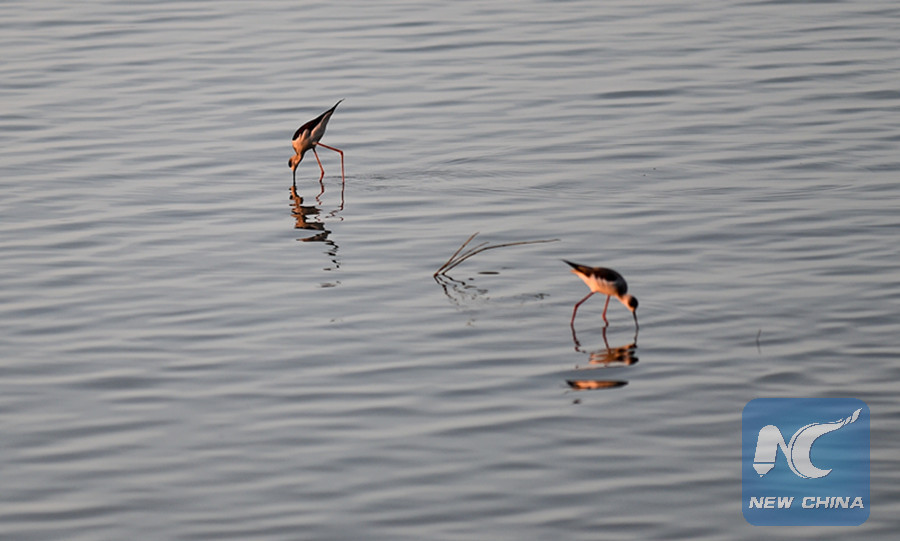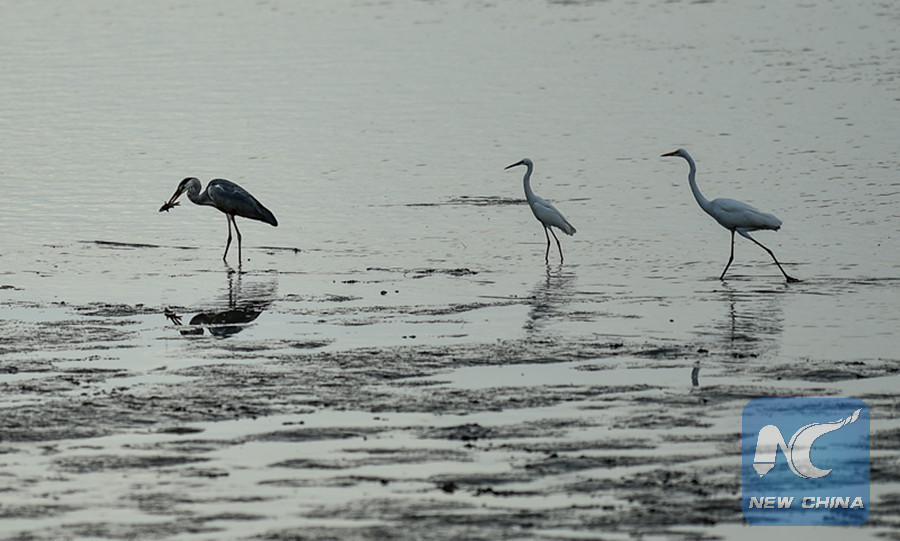
A migratory bird flies over Shenzhen Bay, south China's Guangdong Province, Nov. 9, 2017. (Xinhua photo/Mao Siqian)
SHENZHEN, March 27 (Xinhua) -- In a mangrove nature reserve on the coast of Shenzhen, one of China's most modern and vibrant megacities, about 100,000 migratory birds are enjoying their last moments of leisure before departing for their long flight to Australia.
The birds, including egrets, gulls and geese, bask in the sun on the beach or hover over the sea, surrounded by 300 hectares of swamp in downtown Shenzhen, a city previously best known for its massed ranks of technology companies.
The number of bird species recorded in Shenzhen has grown from 280 in 2000 to 366 last year, according to the city birding association. The trend is the direct result of conservation and protection of the birds during the past 20 years.

Black-winged Stilts forage at Shenzhen Bay, south China's Guangdong Province, Nov. 9, 2017. (Xinhua photo/Mao Siqian)
On the frontline of reform and opening up, waters around Shenzhen were severely polluted as manufacturing grew in the late 1970s and early 1980s. Uncontrolled discharge of liquid and solid waste into the sea depleted fish and shrimp stocks, and ruined vegetation of the reserve. Numbers of migratory birds dwindled.
The reserve's location, at the heart of the commercial zone, also caught the predatory eyes of real estate developers.
"If the reserve had been fallen victim to commercial developers, we would have had nothing to save for future generations," said Li Ming of the the city forestry department.
Shenzhen has contained its chaotic urban sprawl by drawing red lines and improving environmental protection, Li said.

Migratory birds forage at Shenzhen Bay, south China's Guangdong Province, Nov. 9, 2017. (Xinhua photo/Mao Siqian)
During the past 20 years, the city has restored over 200,000 square meters of lakes and planted nearly 40,000 square meters of mangroves. A group of Shenzhen police protect the birds that stay in Shenzhen from October to March each year.
Since 1990, the police contingent has planted about 300,000 mangroves trees, more than 90 percent of which survived. They have also rescued more than 1,800 birds, many of which were injured in storms and gales brought by typhoons.
In 2017 alone, the team rescued more than 200 migratory birds and have deterred illegal fishing, according to Liu Changlong with the border police.
"We are friends of the birds. Sometimes you can see tired little birds getting a free ride on the roof of our cruiser," Liu said.

Migratory birds forage at Shenzhen Bay, south China's Guangdong Province, Nov. 9, 2017. (Xinhua photo/Mao Siqian)
Shenzhen's residents also enjoy the company of the birds, with more people joining birdwatching groups every year.
"Some cities have their iconic parks, for example Central Park in New York and the Olympic Park in Beijing. We're working to make the mangrove reserve ours," Li said.

